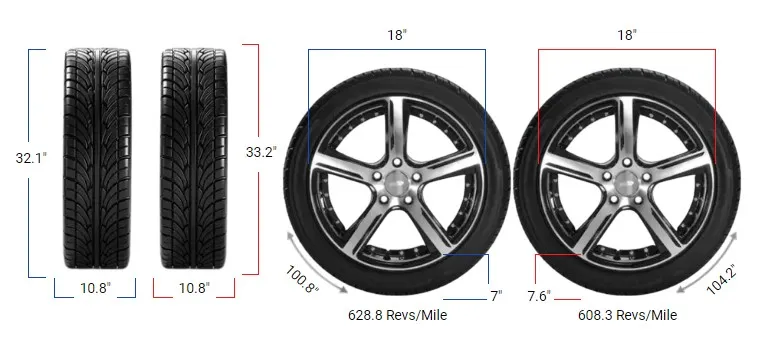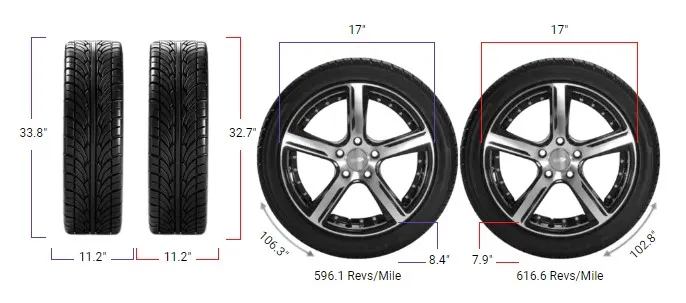Tire Size 235/45r18 vs 245/45r18

Considering upgrading your vehicle’s tires from 235/45R18 to 245/45R18? Discover the key differences and what to expect in this comprehensive guide tailored for drivers seeking enhanced performance and style.
- Improved traction and grip on both wet and dry roads
- Slightly firmer ride quality due to stiffer sidewalls
- Minimal impact on fuel efficiency with only 1.3% diameter difference
- Increased ground clearance for better off-road performance
- Wider tires provide improved flotation on soft surfaces

Fitment Guide
The diameter difference between 235/45R18 and 245/45R18 tires is 1.3%, which falls within the acceptable range.
However, it’s essential to consider the impact of the increased width on your vehicle’s performance and handling.
On-Road Impact
Switching to wider 245/45R18 tires can significantly influence your driving experience on paved roads. Here’s what you can expect:

- Enhanced traction and grip, particularly during cornering and in wet conditions, thanks to the larger contact patch.
- Improved handling and stability at higher speeds due to the increased tire width.
- Slightly firmer ride quality as wider tires have stiffer sidewalls, which may reduce comfort on rough roads.
- Minimal impact on fuel efficiency, with the 1.3% difference in tire diameter resulting in a negligible change in gas mileage.
- Potential for increased road noise due to the larger tire width and stiffer sidewalls.
Off-Road Impact
If you occasionally venture off the beaten path, here’s how the switch to 245/45R18 tires may affect your off-road experience:

- Improved flotation on soft surfaces like sand or mud, as the wider tires distribute the vehicle’s weight more evenly.
- Slightly increased ground clearance (0.18 inches or 4.5 mm) due to the taller sidewall, which can help navigate obstacles.
- Enhanced traction on loose or slippery surfaces, providing better control and reduced wheel slip.
- Potential for increased tire wear when driving on rough or rocky terrain, as the wider tires are more susceptible to punctures and cuts.
235/45r18 vs 245/45r18
Here is a comparison of the tire sizes 235/45R18 and 245/45R18, detailing their specifications and differences.
| Feature | 235/45R18 | 245/45R18 | Difference |
|---|---|---|---|
| Diameter inches (mm) | 26.33 (668.7) | 26.68 (677.7) | 0.35 (9) +1.3% |
| Width inches (mm) | 9.25 (235) | 9.65 (245) | 0.39 (10) +4.3% |
| Circumference inches (mm) | 82.71 (2100.78) | 83.82 (2129.06) | 1.11 (28.27) +1.3% |
| Sidewall Height inches (mm) | 4.16 (105.75) | 4.34 (110.25) | 0.18 (4.5) +4.3% |
| Revolutions per mile (km) | 766.07 (476.01) | 755.90 (469.69) | -10.17 (-6.32) -1.3% |
| Speedo Reading | 20 mph | 20.27 mph | +0.27 mph |
Difference Between 235/45R18 and 245/45R18
The primary difference between 235/45R18 and 245/45R18 tires is the width, with the 245/45R18 being 0.39 inches (10 mm) wider than the 235/45R18.
Can I Use 245/45R18 Instead of 235/45R18?
Yes, you can use 245/45R18 tires instead of 235/45R18 because the overall diameter difference is only 1.3%, which falls within the acceptable 3% range for tire fitment.
How Much Taller Is a 245/45R18 Tire Than a 235/45R18?
A 245/45R18 tire is 0.35 inches (9 mm) taller than a 235/45R18 tire, resulting in a 1.3% increase in overall diameter.
How Much Wider is a 245/45R18 Tire Than a 235/45R18?
A 245/45R18 tire is 0.39 inches (10 mm) wider than a 235/45R18 tire, which represents a 4.3% increase in tire width.
Our Observation
After analyzing the differences between 235/45R18 and 245/45R18 tires, we’ve concluded that the switch offers several benefits for both on-road and off-road driving.
The wider tires provide improved traction, handling, and stability, while the slight increase in diameter contributes to better ground clearance and a marginally taller stance.
However, it’s crucial to consider the potential drawbacks, such as a firmer ride quality, increased road noise, and accelerated tire wear in off-road conditions. Overall, the differences between these tire sizes are relatively minor and should not cause significant issues for most drivers.
When deciding whether to switch from 235/45R18 to 245/45R18 tires, evaluate your driving habits, vehicle type, and desired performance characteristics.
If improved handling and traction are your primary goals, and you’re willing to accept a slightly firmer ride, then making the switch could be a worthwhile upgrade for your vehicle.



